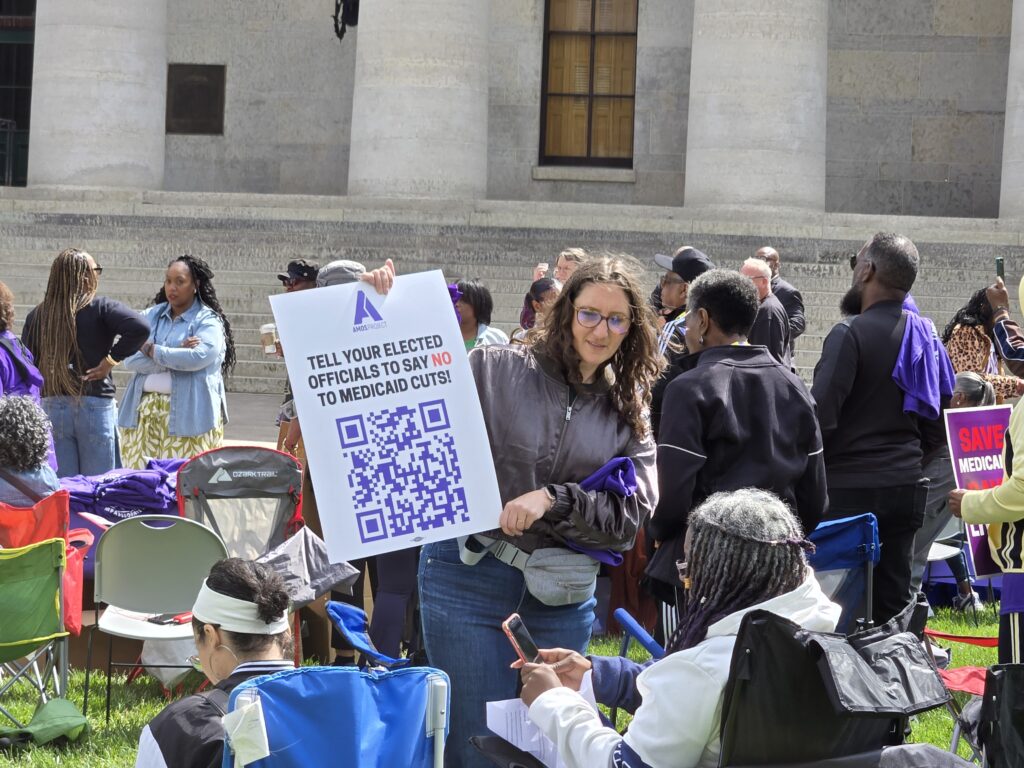Dozens gathered at the Ohio Capitol to protect Medicaid benefits. (Photo by Marty Schladen, Ohio Capital Journal.)
As threats build to Medicaid, the federal-state health program for the poor, even many Ohioans who stand to be affected don’t know it, advocates said Saturday.
Federal fallout
As federal funding and systems dwindle, states are left to decide how and whether to make up the difference.
Read the latest >
Dozens gathered on the west lawn of the Ohio Statehouse to raise awareness that a massive spending bill passed by Republicans in Congress could end up ending health care for more than 750,000 Ohioans.
“People say, ‘Oh, I’m not on Medicaid,’” said Bria Bennett of the Ohio Organizing Collaborative. “But when they hear Caresource (Ohio’s biggest Medicaid managed-care provider), they say ‘Oh yeah, my kids are on Caresource.’ That’s a problem everywhere. People are so focused on ‘How am I getting to work? Is my car going to get me to work? Is my uniform clean for work?’ They’re worried about all those things that trying to dip into the policy things that our politicians talk about is difficult.”
The U.S. House-passed Republican reconciliation budget — President Donald Trump’s “One Big Beautiful Bill” — would hand out $4.6 trillion in tax cuts over 10 years. The University of Pennsylvania’s Wharton School estimated that 70% of the benefit would go to the richest 10% of Americans.
Republicans, such as Iowa Sen. Joni Ernst, have denied that the budget would cut health benefits for Americans. But then she undermined her own argument by saying “We all are going to die.”
SUBSCRIBE: GET THE MORNING HEADLINES DELIVERED TO YOUR INBOX
Parts of the bill, including a strict new work requirement, led the independent, nonpartisan Congressional Budget Office to conclude that it would cost about 10 million Americans their health insurance. That’s nearly half of the 24.6 million Americans who are covered under the Medicaid expansion that was passed as part of the 2010 Affordable Care Act.
Most Medicaid recipients have jobs, and a 2018 assessment in Ohio said that health coverage made it easier for those people to seek and keep employment.
Meanwhile, work requirements have been shown to be ineffective for anything other than hassling people off of the system. Researchers at Harvard University and the Urban Institute found that Arkansas’s work requirement did nothing to boost employment in the state.
The federal government covers 90% of the cost of the Medicaid expansion. In Ohio, Gov. Mike DeWine proposed that if a significant portion of that funding were eliminated, the state would cut those people off — ending health coverage for 770,000 Ohioans.
That’s nearly 7% of the state.
It might come as a surprise for many, but 26% of Ohioans are on Medicaid, and low-income residents are so numerous that 30% of households make 200% or less of the federal poverty level.
Bennett of the Ohio Organizing Collaborative said it’s jargon like that that obscures the dire reality in which millions of Ohioans live.
“I don’t know what 200% of whatever is,” she said. “That’s just a number to me. We’re trying to make things relatable because people don’t necessarily know that it affects them.”
For the record, for a family of four 200% of the federal poverty level is $62,400 a year.
Bennett said such households would be devastated if they lost Medicaid benefits.
“I know folks who have four-plus kids. Because of what they make, all of their kids are on Medicaid,” she said. “If that’s taken away, there are no more doctor’s appointments. There’s no more dentist’s appointments.”
And, she said, those life-saving services shouldn’t be axed to pad the pockets of the wealthy in an era of exploding income inequality.
“We should not be giving tax breaks to the wealthy when the poorest and most vulnerable of us cannot even afford health care,” Bennett said.
SUPPORT: YOU MAKE OUR WORK POSSIBLE
Read the full article here


